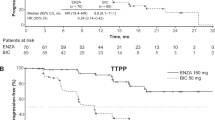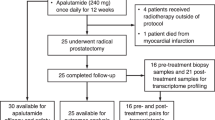Abstract
Trial 24 is one of three placebo-controlled trials within the ongoing bicalutamide (‘Casodex’†) Early Prostate Cancer (EPC) programme evaluating bicalutamide 150 mg/day in addition to radical prostatectomy, radiotherapy or watchful waiting for T1b–4, any N, M0 prostate cancer. In Trial 24, at 5.1 y median follow-up, the addition of bicalutamide significantly (P<0.0001) improved objective progression-free survival (PFS) and prostate-specific antigen PFS compared with standard care alone. There was no significant difference in overall survival (P=0.746). In the context of the whole EPC programme, long-term bicalutamide is not appropriate for localised disease, yet provides advantages in delaying disease progression in patients with locally advanced prostate cancer.
This is a preview of subscription content, access via your institution
Access options
Subscribe to this journal
Receive 4 print issues and online access
$259.00 per year
only $64.75 per issue
Buy this article
- Purchase on Springer Link
- Instant access to full article PDF
Prices may be subject to local taxes which are calculated during checkout



Similar content being viewed by others
References
Smith Jr JA, Soloway MS, Young MJ . Complications of advanced prostate cancer. Urology 1999; 54 (Suppl 6A): 8–14.
Pitceathly C, Maguire P . The psychological impact of cancer on patients' partners and other key relatives: a review. Eur J Cancer 2003; 39: 1517–1524.
Rosenfeld BD et al. Differences in health-related quality of life of prostate cancer patients based on disease stage. Proc Am Soc Clin Oncol 2003; 22: 438; abstract 1758.
Penson DF et al. The economic burden of metastatic and prostate specific antigen progression in patients with prostate cancer: findings from a retrospective analysis of health plan data. J Urol 2004; 171: 2250–2254.
See WA et al. Bicalutamide as immediate therapy either alone or as adjuvant to standard care of patients with localized or locally advanced prostate cancer: first analysis of the early prostate cancer program. J Urol 2002; 168: 429–435.
Wirth MP et al. Bicalutamide 150 mg in addition to standard care in patients with localized or locally advanced prostate cancer: results from the second analysis of the early prostate cancer program at median follow up of 5.4 years. J Urol 2004; 172: 1865–1870.
Iversen P et al. Bicalutamide (150 mg) versus placebo as immediate therapy alone or as adjuvant to therapy with curative intent for early nonmetastatic prostate cancer: 5.3-year median followup from the Scandinavian Prostate Cancer Group study number 6. J Urol 2004; 172: 1871–1876.
Wirth M et al. Bicalutamide (Casodex) 150 mg as immediate therapy in patients with localized or locally advanced prostate cancer significantly reduces the risk of disease progression. Urology 2001; 58: 146–151.
Kirk D, on behalf of the Medical Research Council Prostate Cancer Working Party Investigators Group. Immediate vs. deferred hormone treatment for prostate cancer: how safe is androgen deprivation? BJU Int 2000; 86 (Suppl 3): 220; abstract MP6.1.07.
Ullrich PM et al. Cancer fear and mood disturbance after radical prostatectomy: consequences of biochemical evidence of recurrence. J Urol 2003; 169: 1449–1452.
Zietman AL et al. Conservative management of prostate cancer in the prostate specific antigen era: the incidence and time course of subsequent therapy. J Urol 2001; 166: 1702–1706.
Moeremans K, Caekelbergh K, Annemans L . Cost-effectiveness analysis of bicalutamide (Casodex™) for adjuvant treatment of early prostate cancer. Value Health 2004; 7: 472–481.
Bolla M et al. Long-term results with immediate androgen suppression and external irradiation in patients with locally advanced prostate cancer (an EORTC study): a phase III randomised trial. Lancet 2002; 360: 103–108.
Messing E et al. Immediate hormonal therapy compared with observation after radical prostatectomy and pelvic lymphadenectomy in men with node positive prostate cancer: results at 10 years of EST 3886. J Urol 2003; 169: 396; abstract 1480.
Pilepich MV et al. Phase III trial of androgen suppression adjuvant to definitive radiotherapy. Long term results of RTOG study 85-31. Proc Am Soc Clin Oncol 2003; 22: 381; abstract 1530.
Iversen P et al. Bicalutamide monotherapy compared with castration in patients with nonmetastatic locally advanced prostate cancer: 6.3 years of follow up. J Urol 2000; 164: 1579–1582.
Daniell HW et al. Progressive osteoporosis during androgen deprivation therapy for prostate cancer. J Urol 2000; 163: 181–186.
Sieber PR et al. Bicalutamide 150 mg maintains bone mineral density during monotherapy for localized or locally advanced prostate cancer. J Urol 2004; 171: 2272–2276.
Smith MR et al. Bicalutamide monotherapy versus leuprolide monotherapy for prostate cancer: effects on bone mineral density and body composition. J Clin Oncol 2004; 22: 2546–2553.
Eaton AC, Makris A, Makris A . Once weekly tamoxifen in the prevention of gynaecomastia and breast pain secondary to bicalutamide therapy. J Urol 2004; 171: 282; abstract 1069.
Boccardo F et al. Tamoxifen (T) is more effective than anastrozole (A) in preventing gynecomastia induced by bicalutamide (B) monotherapy in prostate cancer (pca) patients (pts). Proc Am Soc Clin Oncol 2003; 22: 400; abstract 1608.
Tyrrell CJ et al. Prophylactic breast irradiation with a single dose of electron beam radiotherapy (10 Gy) significantly reduces the incidence of bicalutamide-induced gynecomastia. Int J Radiat Oncol Biol Phys 2004; 60: 476–483.
Van Poppel H et al. Efficacy and tolerability of radiotherapy as treatment for bicalutamide-induced breast pain and gynaecomastia in prostate cancer. Eur J Cancer 2003; 1 (Suppl 5): S265; abstract 881.
Wirth M et al. Response to second-line hormonal therapy following progression on bicalutamide (‘Casodex’) 150 mg monotherapy. Eur Urol Suppl 2004; 3: 58; abstract 223.
Acknowledgements
Editorial support was provided by Sarah Goodger, PhD; AstraZeneca provided financial assistance for this support.
Author information
Authors and Affiliations
Consortia
Corresponding author
Additional information
†‘Casodex’ is a trademark of the AstraZeneca group of companies
Rights and permissions
About this article
Cite this article
Wirth, M., Tyrrell, C., Delaere, K. et al. Bicalutamide (‘Casodex’) 150 mg in addition to standard care in patients with nonmetastatic prostate cancer: updated results from a randomised double-blind phase III study (median follow-up 5.1 y) in the early prostate cancer programme. Prostate Cancer Prostatic Dis 8, 194–200 (2005). https://doi.org/10.1038/sj.pcan.4500799
Received:
Accepted:
Published:
Issue Date:
DOI: https://doi.org/10.1038/sj.pcan.4500799
Keywords
This article is cited by
-
Cardiovascular events associated with androgen deprivation therapy in patients with prostate cancer: a systematic review and meta-analysis
World Journal of Urology (2015)
-
Uro-Onkologie – Update 2009
Der Urologe (2009)
-
Impact of preoperative antiandrogen medication and nerve-sparing surgery on the outcome of radical prostatectomy
International Urology and Nephrology (2008)
-
Bicalutamide (Casodex) 150 mg plus standard care in early non-metastatic prostate cancer: results from Early Prostate Cancer Trial 24 at a median 7 years' follow-up
Prostate Cancer and Prostatic Diseases (2007)
-
Optimal treatment of locally advanced prostate cancer
World Journal of Urology (2007)



